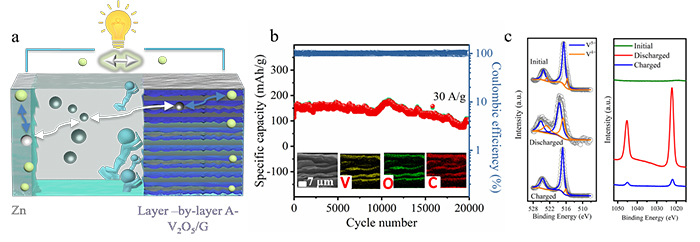The aqueous zinc-ion batteries are competitive, easy-processing and safe electrochemical energy storage devices. However it suffers from the poor cyclability and unattainable capacity caused by dissolution of vanadium, inferior conductivity, volume expansion and structural instability of typical high-capacity vanadium based cathode materials.
Recently, a research group led by Prof. WU Zhongshuai from the Dalian Institute of Chemical Physics of the Chinese Academy of Sciences developed high-capacity and ultra-long-life rechargeable aqueous zinc ion batteries (ZIBs) with stable layer-by-layer amorphous 2D heterostructures combining high conductive graphene and amorphous V2O5 (A-V2O5/G-ZIBs) by 2D template ion-adsorption approach.
This work was published in Energy Storage Materials on June 23.

(a) Schematic of the discharging and charging states of A-V2O5/G-ZIBs with Zn as anode and A-V2O5/G heterostrcuture as cathode. (b) Long cyclability of A-V2O5/G-ZIBs at 30 A/g and cross-section EDX mapping of V, O and C elements on 2D A-V2O5/G heterostructures (inset). (c) V 2p3/2 and Zn 2p3/2 XPS spectra of 2D A-V2O5/G cathode at pristine, fully discharged and charged states. (Image by WANG Xiao)
"The ZIBs we developed presented high capacity of 447 mAh/g at 0.3 A/g, extraordinary rate capability of 202 mAh/g at 30 A/g, and ultra-long lifespan up to 20,000 cycles at 30 A/g, Owing to the unique features with strong synergistic effect," said Prof. WU.
Moreover, the new-concept planar interdigital zinc ion micro-batteries, constructed by mask-assisted filtration strategy, displayed large volumetric capacity of 63 mAh/cm3 at 0.2 mA/cm2, high volumetric energy density of 49 mWh/cm3, robust flexibility, and impressive modular integration in series and in parallel for boosting the capacity and voltage output. They were demonstrative of great potential as microscale power sources.
This work provides various opportunities to construct layer-by-layer stacked 2D heterostructures with fast ion-electron conductivity for ZIBs and other batteries.
This work was supported by National Natural Science Foundation of China, National Key R&D Program of China. (Text by WANG Xiao)